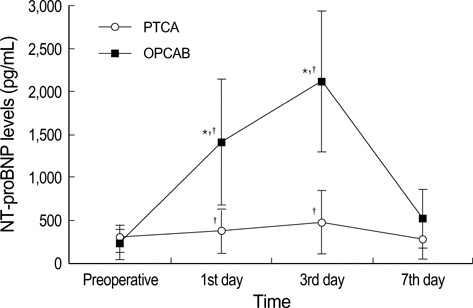J Korean Med Sci.
2007 Feb;22(1):16-19. 10.3346/jkms.2007.22.1.16.
Changes in N-terminal Pro B-type Natriuretic Peptide Concentration: Comparative Study of Percutaneous Transluminal Coronary Angioplasty and Off-Pump Coronary Artery Bypass Graft
- Affiliations
-
- 1Department of Thoracic and Cardiovascular Surgery, Korea University Medical Center, Seoul, Korea. harkkim@korea.ac.kr
- 2Department of Cardiology, Korea University Medical Center, Seoul, Korea.
- KMID: 1713223
- DOI: http://doi.org/10.3346/jkms.2007.22.1.16
Abstract
- The goal of this study was to compare the effects of different reperfusion methods on N-terminal B-type natriuretic peptide (NT-proBNP) in percutaneous transluminal coronary angioplasty (PTCA) or off-pump coronary artery bypass (OPCAB) patients. Fifty subjects were enrolled in the study, 32 patients received PTCA and 18 OPCAB. An NT-proBNP measurement was performed before intervention and at 1, 3, and 7 days after the procedures. NT-proBNP levels were not significantly different before intervention (PTCA group 297+/-147.3 vs. OPCAB group 235+/-167.8 pg/mL, p>0.05). However, 1 day after the procedures, NT-proBNP levels were higher in the OPCAB group (PTCA 375+/-256.4 vs. OPCAB 1,415+/-737.6 pg/mL, p<0.05), after 3 days NT-proBNP reached peak levels (PTCA 480+/-363.0 vs. OPCAB 2,119+/-818.4 pg/mL, p<0.05), and levels were reduced after 7 days (PTCA 292+/-243.7 vs. OPCAB 522+/-334.0 pg/mL, p>0.05). PTCA induced a mild and transient increase in NT-proBNP concentration, but OPCAB caused sustained high NT-proBNP levels during the 7 day postoperatively. However, differences between NT-proBNP levels associated with these two modalities showed a tendency to decrease rapidly postoperatively.
Keyword
MeSH Terms
Figure
Reference
-
1. Sudoh T, Kangawa K, Minamino N, Matsuo H. A new natriuretic peptide in porcine brain. Nature. 1988. 332:78–81.
Article2. Levin ER, Gardner DG, Samson WK. Natriuretic peptides. N Engl J Med. 1998. 339:321–328.
Article3. Cowie MR, Struthers AD, Wood DA, Coats AJ, Thompson SG, Poole-Wilson PA, Sutton GC. Value of natriuretic peptides in assessment of patients with possible new heart failure in primary care. Lancet. 1997. 350:1349–1353.
Article4. Richards AM, Nicholls MG, Yandle TG, Frampton C, Espiner EA, Turner JG, Buttimore RC, Lainchbury JG, Elliott JM, Ikram H, Crozier IG, Smyth DW. Plasma N-terminal pro-brain natriuretic peptide and adrenomedullin: new neurohormonal predictors of left ventricular function and prognosis after myocardial infarction. Circulation. 1998. 97:1921–1929.5. Omland T, Persson A, Ng L, O'Brien R, Karlsson T, Herlitz J, Hartford M, Caidahl K. N-terminal pro-B-type natriuretic peptide and long-term mortality in acute coronary syndromes. Circulation. 2002. 106:2913–2918.
Article6. Tateishi J, Masutani M, Ohyanagi M, Iwasaki T. Transient increase in plasma brain (B-type) natriuretic peptide after percutaneous transluminal coronary angioplasty. Clin Cardiol. 2000. 23:776–780.
Article7. Watanabe M, Egi K, Hasegawa S, Tanaka H, Ohshima H, Sakamoto T, Sunamori M. Significant of serum atrial and brain natriuretic peptide release after coronary artery bypass grafting. Surg Today. 2003. 33:671–673.8. Palazzuoli A, Carrera A, Calabria P, Pastore M, Quatrini I, Vecchiato L, Campagna MS, Palazzuoli V, Nuti R. Brain natriuretic peptide levels during cardiac reperfusion: comparison between percutaneous coronary angioplasty and aorto-coronaric bypass. Clin Chim Acta. 2004. 342:87–92.
Article9. Mark DB, Felker GM. B-type natriuretic peptide: a biomarker for all seasons. N Engl J Med. 2004. 350:718–720.10. Kikuta K, Yasue H, Yoshimura M, Morita E, Sumida H, Kato H, Kugiyama K, Ogawa H, Okumura K, Ogawa Y, Nakao K. Increased plasma levels of B-type natriuretic peptide in patients with unstable angina. Am Heart J. 1996. 132:101–107.
Article11. Marumoto K, Hamada M, Hiwada K. Increased secretion of atrial and brain natriuretic peptides during acute myocardial ischemia induced by dynamic exercise in patients with angina pectoris. Clin Sci. 1995. 88:551–556.12. Bail DH, Kofler M, Ziemer G. Brain natriuretic peptide (BNP) in patients undergoing coronary artery bypass grafting. Thorac Cardiovasc Surg. 2004. 52:135–140.
Article13. Morimoto K, Mori T, Ishiguro S, Matsuda N, Hara Y, Kuroda H. Perioperative changes in plasma brain natriuretic peptide concentrations in patients undergoing cardiac surgery. Surg Today. 1998. 28:23–29.
Article14. Chello M, Mastroroberto P, Perticone F, Cirillo F, Bevacqua E, Olivito S, Covino E. Plasma levels of atrial and brain natriuretic peptides as indicators of recovery of left ventricular systolic function after coronary artery bypass. Eur J Cardiothorac Surg. 2001. 20:140–146.
Article15. Mair P, Mair J, Bleier J, Hormann C, Balogh D, Puschendorf B. Augmented release of brain natriuretic peptide during reperfusion of the human heart after cardioplegic cardiac arrest. Clin Chim Acta. 1997. 261:57–68.
Article16. Suttner SW, Boldt J. Natriuretic peptide system: physiology and clinical utility. Curr Opin Crit Care. 2004. 10:336–341.
Article17. Matsushita Y, Okamura Y, Iida H, Mochizuki Y, Mori H, Yamada Y, Shibasaki I, Shimada K. Usefulness of OPCAB from the viewpoint of fluctuation level of blood natriuretic peptides. Kyobu Geka. 2001. 54:321–325.18. Kerbaul F, Giorgi R, Oddoze C, Collart F, Guidon C, Lejeune PJ, Villacorta J, Gouin F. High concentrations of N-BNP are related to non-infectious severe SIRS associated with cardiovascular dysfunction occurring after off-pump coronary artery surgery. Br J Anaesth. 2004. 93:639–644.19. Tayama K, Takamori S, Mitsuoka M, Hayashi A, Tamura K, Mifune H, Shirouzu K. Natriuretic peptides after pulmonary resection. Ann Thorac Surg. 2002. 73:1582–1586.
Article20. Menon AK, Albes JM, Oberhoff M, Karsch KR, Ziemer G. Occlusion versus shunting during MIDCAB: effects on left ventricular function and quality of anastomosis. Ann Thorac Surg. 2002. 73:1418–1423.
Article
- Full Text Links
- Actions
-
Cited
- CITED
-
- Close
- Share
- Similar articles
-
- Percutaneous transluminal coronary angioplasty for ostial stenosis of the left coronary artery
- A case of arteriovenous fistula with drainage into the coronary sinus during the percutaneous tranluminal coronary angioplasty of chronic total occlusion of circumflex coronary artery
- Percutaneous Transluminal Angioplasty of a Stenosis of an Internal Mammary Artery Graft
- Aspiration Thromboembolectomy in the Management of Acute Coronary Occlusion during Pertaneous Transluminal Coronary Angioplasty
- "Off-Pump" Coronary rtery bypass Grafting in Multi-vessel Coronary Disease: Two Cases


